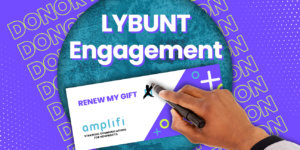In order to be strategic and relevant with your fundraising communications, you need to capture and put to use meaningful donor data. For many organizations, talk of data can send staffers running for the hills. That’s totally understandable. Collecting data and keeping it clean can be difficult. However, things become much simpler if you have a better understanding of what to measure and how to apply it in your appeals.
Better data means a better picture of your donors.
If you want to communicate effectively with your donors, you have to know as much about them as possible. Plain and simple. It’s easy enough to pull a report of who gave last year and send a mass appeal, but your chances of getting a high return with increased gifts are slim to none. Why? Because the communication as a whole probably doesn’t speak to them on a personal level and makes them feel unknown and unheard.
80% of organizations use a single data point to target donors, leaving numerous areas untapped and underutilized. Multiple data points (e.g. gift history, geography, personal interests, or how they came to know you) allows organizations to target donors for greater relevancy. More information about your donor also means you’ll be able to figure out the best way to engage with them. Plus, knowing a simple thing like who is more likely to respond to email as opposed to direct mail can go a long way to maximizing your communication budget.
Measure these 4 things to optimize gift potential.
Four things that everyone should analyze post-campaign are:
- Response rate
- Average gift size
- Cost per donor
- Return on investment
What this will do is help you shape future appeals and predict future results. Doing everything you can to get a clear picture of engagement to optimize future moves is one of our mantras here, and we tell it to everyone. Evaluating these four areas also helps you make year over year comparisons.
You might be questioning whether or not this is important so long as you did everything you were supposed to. Not necessarily. If you raised less money this year compared to last, don’t you want to know why? After all, you’re spending money on these campaigns so they should work. A detailed evaluation using the Big 4 might give you the answer. Let’s say upon further analysis you discovered that in 2014, your response rate was lower but your average gift amount was higher. From this you might surmise that a lower average gift rate in 2015 was due to a low-range ask string on your response card. Again, it’s all about optimizing.
The Wrap Up
Data is one of the most powerful tools you can employ when developing a long-term, sustainable fundraising strategy. Withe a complete picture of your constituents, you can change the way you interact with donors and make your ask more personal and more consistent. Strong data doesn’t just help you ask better and smarter; it can greatly assist in the stewardship process. What happens after the ask is almost if not more important than the ask itself, so more personal and relevant storytelling will keep donors engaged and meaningfully connected.
You Might Also Enjoy:
+ Keep Communications Afloat: The Battle Against Donor Attrition
+ Before You Make the Ask: Build Relationships By Being Personal
+ Understanding a Campaign Flow
Like what you see? Stay in touch!












